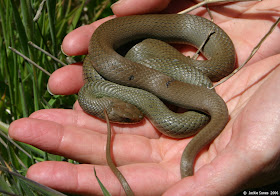Peter discovered this juvenile snake in his garage in Salmon Creek on 13 October 2012. Because I had yet to post about local snakes, I asked if he'd mind contributing to the blog, and thankfully he agreed to share his photographs of this beautiful reptile.
Do you have a guess about which species this is?
Here's a slightly different view:
There are a couple of important characters to look at. Note the size of the eyes and the texture of the scales. Although the overall color pattern can be similar in Gopher Snakes and juvenile Racers, the large eyes and smooth scales (lacking keels or ridges) help identify this as a Racer (Coluber constrictor). [Gopher Snakes would have smaller eyes and keeled scales.]
The brown saddles and splotches on the upper surface contrast with the relatively pale lower surface (see next photo).
Important cautionary
note: Don't try this at home unless you're experienced handling snakes!
Although not poisonous, Racers are prone to biting when defending
themselves.
Racers lay eggs in early summer. The eggs hatch in late summer. After reading about Racers, the length of this juvenile (~10 inches or 250 mm) sounds about right for a hatchling. One-year olds are about twice as long.
You may be more familiar with adult Racers. They look very different from the juveniles, with a uniformly olive or brown dorsal surface and a cream or pale yellow ventral surface (next two images). There may be a greenish or bluish tint.
Claudia held this Racer for a photograph on 3 June 2006. We found it in the grassy field between the Bodega Dunes and Highway 1. [It looks like it might have been healing from a minor injury — had it been caught and then dropped by a predator?]
When there is a striking color change between the juvenile and adult stage, it's called an ontogenetic shift (ontogenetic means appearing during the course of development of an organism, e.g., as it matures.)
Any guesses about why there would be an ontogenetic shift in color patterns in Racers? Why are they highly patterned when young and uniformly colored as adults?
One paper I read suggested that the juveniles depend more on camouflage (and aggression) when defending themselves, while adults depend more on speed to escape from predators.
On Bodega Head, Racers are much less common than garter snakes (more about them in future posts!). Although I haven't done any extensive searching, I've probably seen half a dozen Racers on Bodega Head during the past eight years. It's a lucky day when you see one!





Fascinating - especially the eye size differential. Thanks - as always. Never know what to expect from your eclectic POV but always interesting. Thank you.
ReplyDelete